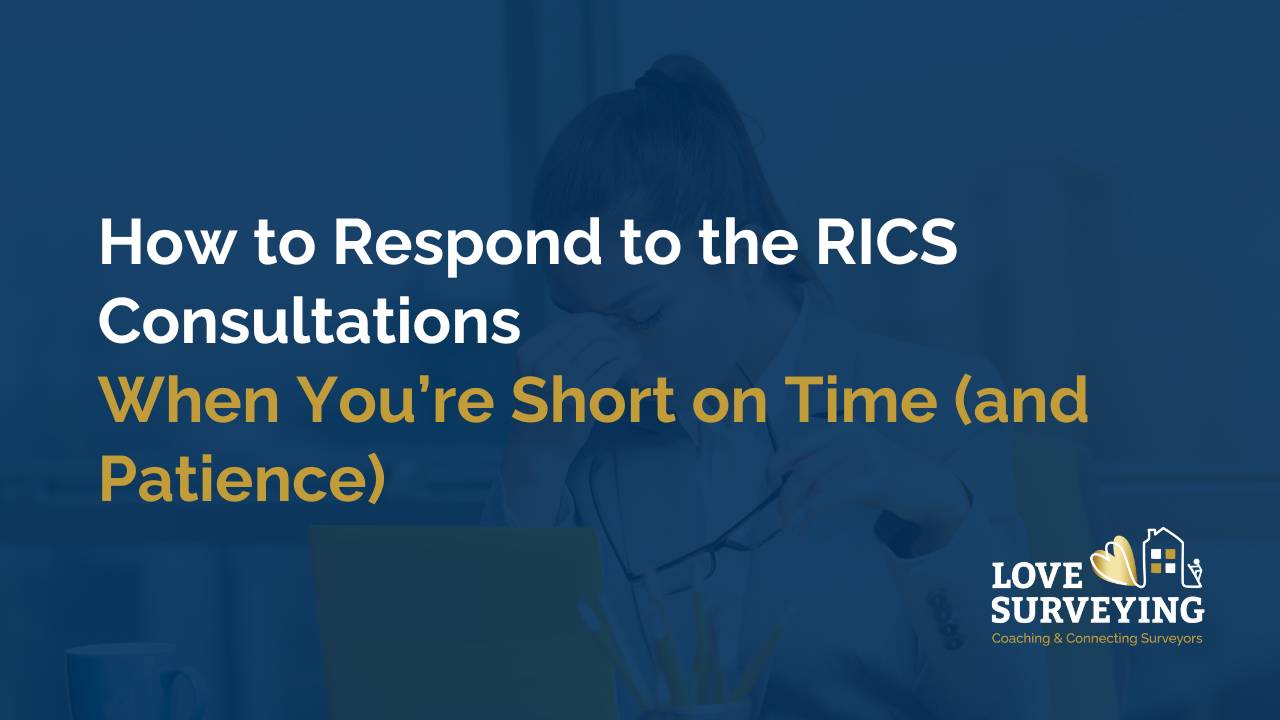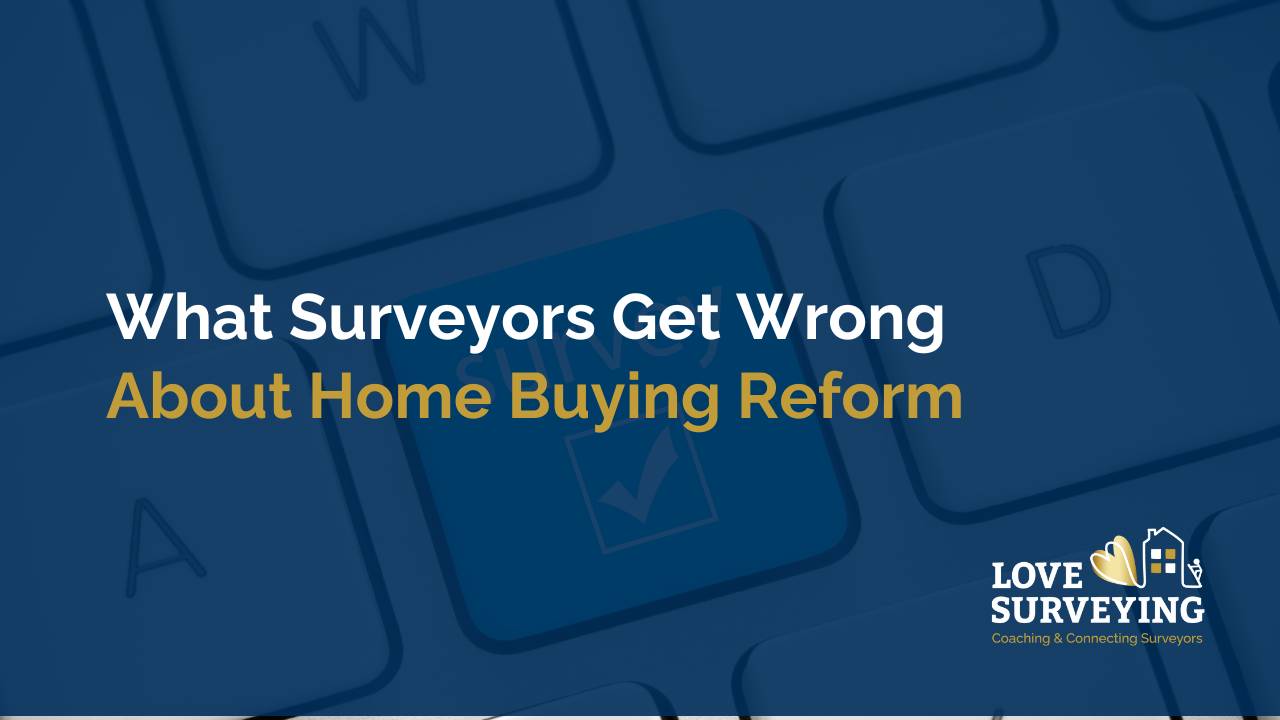How to Respond to the RICS Consultations When You’re Short on Time (and Patience)
Oct 10, 2025
If you’ve looked at the latest RICS consultations and felt your shoulders tighten, you’re not alone. Between the Home Survey Standard (HSS) 2nd Edition and the Registration and Regulation Scheme proposals, many surveyors are wondering how they’ll find the time, or the headspace, to respond.
And then comes the guilt trip. I’ve heard a few webinars quote how “only a handful of questionnaires” or “just a few comments” have been submitted. But guilt doesn’t drive engagement; it discourages it. Most of us care deeply about our work, our clients, and our profession; we’re just also trying to run businesses, serve clients, and stay sane in the process.
So here’s a calm, step-by-step way to engage meaningfully with the RICS consultations, even if you only have an hour. Get your highlighters ready; you get to log up to 2 hours of informal CPD.
Step 1: Understand the structure
There are two RICS consultations - the Home Survey Standard (HSS) 2nd Edition Draft Standard and the Home Surveys Regulatory Scheme Draft Proposal. They are separate, but you access the consultations through the same link. You’ll get the most out of it if you know how they fit together:
- The Main Document (Draft Standard)
This is where the real substance lies - the updated definitions, requirements, and expectations.
Read this first, ideally skimming section by section. I found it helpful to highlight what made sense, what was unclear, and what I think will be hard to apply in practice. You add your comments by section, but as a heads up, it means you get an email confirmation for each one.
- The Online Questionnaire
This is the official feedback form. It asks for your overall views and gives you space to comment on specific parts of the document.
This is what RICS will count and analyse. Social posts don’t count - only submissions made here are included in their formal review.
If you only fill in the questionnaire without reading the main document, you’ll miss the context.
If you only read the document and don’t submit, your insights won’t be heard.
Both matter - but you can do both efficiently.
Step 2: Set realistic expectations
You do not have to comment on everything.
Instead:
Pick a couple of sections where you have direct experience or strong views - for example, scope of inspection, language and accessibility, report structure, or consumer communication.
Make clear, practical points drawn from real-world evidence. Context will really help the working group understand, and a structured format might also help you with your thoughts.
If every surveyor commented on just a few sections they know best, we’d have a far richer, more representative consultation response overall.
Step 3: The quick prep method (15–30 minutes)
Here’s how to make your submission count without burning out.
5 minutes - Set up
Open:
The RICS HSS consultation page (questionnaire link).
The main document (PDF).
A blank note or document for your draft responses.
10 minutes - Read with purpose
Skim the main document and focus on:
Changes from the 1st Edition
Clarity - can you explain it to consumers? Does it make sense?
Practicality - can you realistically apply this on-site or in your workflow?
Risk - does it help reduce claims, or add confusion?
Jot your thoughts - you don’t need essays.
15 minutes - Add your comments
Copy and paste this short template into the questionnaire’s comment boxes where relevant, or just follow the format in the example below:
Overall View: Agree in principle, but needs more clarity.
Why it Matters: Defines what consumers think we’ve inspected and therefore what we’re liable for.
What Works Well: Acknowledges limits of intrusive investigation.
Comment: The proposed wording at [section or paragraph] is unclear/hard to apply because [reason]. In practice, this could cause [risk/consumer confusion].
Concerns: The phrase “all reasonably accessible areas” is open to interpretation. Risk of inconsistency across different levels and firms.
Suggested Improvement: Add a glossary definition for “reasonably accessible” and link it to consumer guidance.
Desired Outcome: Clarity that safety, practicality, and agreed scope define limits - not theoretical access.
That’s it - clear, evidence-based, and constructive. Then repeat the process for the second consultation.
Step 4: Submit, even if it’s partial
RICS have confirmed that partial submissions count.
You don’t need to finish every section. You can even go back later if you want to add more.
What matters is that your real-world perspective is captured - because it’s often missing in formal drafting processes. A small group of people can never account for every eventuality or circumstance. That's the point of the consultation.
Step 5: If you’re feeling frustrated
This is normal. Many surveyors feel unheard or worn down by repeated consultations. Before you click “Submit”:
- Vent privately first if you need to — don’t let emotion spill into your formal response.
- Focus on solutions. For every criticism, suggest a fix — even if small.
Remember: your professional insight is what gives the document credibility.
Step 6: Encourage others - without shaming
A better approach than “we've only 72 responses” is:
“I’ve just sent my HSS comments - it took me 30 minutes using the questionnaire and main document side by side. You don’t need to do it all - just share what you know best.”
That’s how we build momentum.
Why It Matters
The next few months will shape what our profession looks like for years to come.
- The Home Survey Standard (HSS) determines how we communicate the condition of a property, what clients understand, and how we protect ourselves and the public from risk. The proposed second edition changes language, scope, and expectations - including what consumers might one day compare between surveyors.
- The Registration and Regulation Scheme affects who must register with RICS, and under what conditions. It touches on independence, accountability, and the future of small practices and self-employed surveyors.
If you don’t contribute, those decisions will still be made, just without your perspective and you deserve for your views to be heard.
This is your chance to say what’s realistic, what’s confusing, and what’s missing. Even short comments make a difference. You don’t need to defend the past or draft a new policy, just help shape something that works in practice.
Don’t underestimate the power of a few grounded, honest comments. Change doesn’t happen because the loudest people shout; it happens because the right people - the ones doing the work - take a moment to speak up. As they say, “You don’t need to fix the whole thing. Just leave it better than you found it.”
A Personal Note
These thoughts come from my experience of over 20 years in surveying and supporting both consumers and surveyors. They’re simply my perspective - shared to open up discussion and encourage more voices to feed into the consultation. If you have a view, please take a moment to respond - your input really does make a difference. This is the link to the consultation.
Enjoyed this article?
- You might also like: Reservation Agreements - What Surveyors Need to Know
- Find it useful? Please share it with friends or colleagues who might benefit.
Want to support my work? Leave me a quick Google Review or Buy Me a Coffee ☕ Every little helps as a small business.




